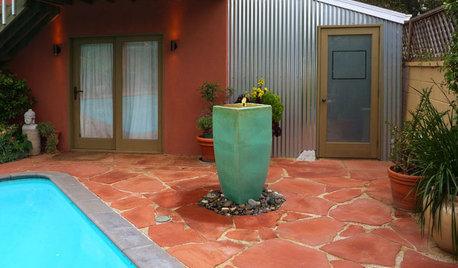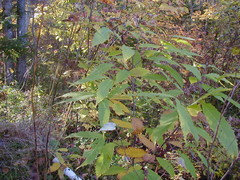converting lawn into forest
viper114
9 years ago
Featured Answer
Comments (33)
gardengal48 (PNW Z8/9)
9 years agowisconsitom
9 years agoRelated Discussions
convert lawn to stepables
Comments (0)are there any stepables that will choke out weeds...See MoreHow to converting farm field to lawn?
Comments (9)I think you could get what you want much easier by just "drilling." I would wait until after your last bailing this summer/fall; mow it once or twice - shorter the second time; then drill it with fescue/rye mix but not too late in the fall. Then just keep it mowed from then on and I think you will eventually reclaim your land for grass....See MoreHas anyone converted their lawn into a succulent garden?
Comments (118)Thank you. I have been shy posting here because I kill more than I buy these days. Bad winter , bad wet years. I guess I might have posted in the wrong thread since I did not get rid of a lawn, but started out with raw hill country marl. I guess I was supposed to put a lawn in but I never got the memo. I wondered why I was supposed to make my beautiful hill country look like some place in North Carolina or Pennsylvania when I moved out here, because I thought it was beautiful the way it was. Things have to live in my conditions.. I had no choice with the water use and me living on Rainwater. Texas is a hard place to garden . It is either TOO hot TOO cold, TOO dry, TOO wet and it can go from too dry (right now my cistern is 1/4 full) to TOO wet (please I need the water ). Don't get me started on the soil. I have no soil so I have been bringing yards of Decomposed granite sand , gravel and compost in . The limey marl is about 1" under the soil in the area of this garden. Nothing really grew here very tall. It is ongoing. We are too hot for northern opuntias , too cold for southern cactus. I have learned to collect from southern New mexico and the northern Big bend area. I like their Eastern grasslands over the dryer points to the west, but mountainous Arizona has plants I can use. I also look for limestone soiled lands and not sandstone based lands. It isn't totally hill country. I guess I am not a purist about anything....See MoreConverting a Fescue Lawn to Bermuda by tilling and seeding
Comments (4)I'll start with the elephant in the room. Rototilling is the very worst thing you can do to prepare for a lawn, and it only gets worse for bermuda. So the term, 'proper tilling' means nothing. There is no proper tilling. There is only improper tilling. Why? I'll summarize The surface will settle unevenly and it is very hard to ever get a smooth surface again. It kills the microbes that give your soil health. It destroys the existing soil structure both structurally and biologically (sum of 1 and 2). Reestablishing a new soil structure takes 3 years. Grass seed sprouts on the top surface of the soil. You don't need to bury the seed into soft soil. Yes, nurture the current grass until the very day you decide to kill it all. Do that at the end of April. Spray with RoundUp and start watering lightly, 3x per day, every day for a week. This will sprout all the crabgrass and other summer annual weeds that may be lurking in the soil. After a week of daily watering, spray the area again with RU to kill everything that sprouted during the week. This approach may work better if you start watering a week before the first RU app. Oh and mow it short to let the sunlight in. Search this forum for the topic of sprigging. That is another way to get a very expensive lawn for not much money. You do some prep work, but the result is an expensive hybrid lawn for the cost of a few pieces of sod....See Morespedigrees z4VT
9 years agoken_adrian Adrian MI cold Z5
9 years agoviper114
9 years agolast modified: 9 years agowisconsitom
9 years agolast modified: 9 years agoken_adrian Adrian MI cold Z5
9 years agoken_adrian Adrian MI cold Z5
9 years agodrrich2
9 years agoviper114
9 years agolast modified: 9 years agobengz6westmd
9 years agojocelynpei
9 years agowisconsitom
9 years agodrrich2
9 years agobengz6westmd
9 years agowisconsitom
9 years agojocelynpei
9 years agowisconsitom
9 years agojocelynpei
9 years agodrrich2
9 years agowisconsitom
9 years agokrnuttle
9 years agoviper114
9 years agodrrich2
9 years agowisconsitom
9 years agospedigrees z4VT
9 years agowisconsitom
9 years agoctnchpr
9 years agowisconsitom
9 years agoEmbothrium
9 years agolast modified: 9 years agojocelynpei
9 years agoMDLN
9 years ago
Related Stories

FRONT YARD IDEASBefore and After: Front Lawn to Prairie Garden
How they did it: Homeowners create a plan, stick to it and keep the neighbors (and wildlife) in mind
Full Story
GROUND COVERSGive Your Lawn a Taste of the Wild
Consider the joys of an irregularly trimmed meadow lawn: It’s ecofriendly, visually interesting and still good for romping
Full Story
SAVING WATERHouzz Call: Are You Letting Go of Your Lawn?
Many facing a drought are swapping turf for less thirsty plantings. If you’re one of them, we’d like to hear about it
Full Story
EARTH DAYThe Case for Losing the Traditional Lawn
Work less, help the environment and foster connections by just saying no to typical turf
Full Story
LIVING ROOMSHow to Convert Your Wood-Burning Fireplace
Learn about inserts and other options for switching your fireplace from wood to gas or electric
Full Story
BEFORE AND AFTERSMore Room, Please: 5 Spectacularly Converted Garages
Design — and the desire for more space — turns humble garages into gracious living rooms
Full Story
HOUZZ TVHouzz TV: This Dream Midcentury Home in a Forest Even Has Its Own Train
Original wood ceilings, a cool layout and, yes, a quarter-scale train persuaded these homeowners to take a chance on a run-down property
Full Story
GREAT HOME PROJECTSHow to Replace Your Lawn With a Garden
New project for a new year: Lose the turfgrass for energy savings, wildlife friendliness and lower maintenance
Full Story
BEFORE AND AFTERSSee 6 Yards Transformed by Losing Their Lawns
Wondering whether a turf lawn is the best use of your outdoor space? These homeowners did, and they found creative alternatives
Full Story
LANDSCAPE DESIGNGet Along With Less Lawn — Ideas to Save Water and Effort
Ditch the mower and lower your water bill while creating a feast for the eyes with diverse plantings and gathering places
Full Story







viper114Original Author